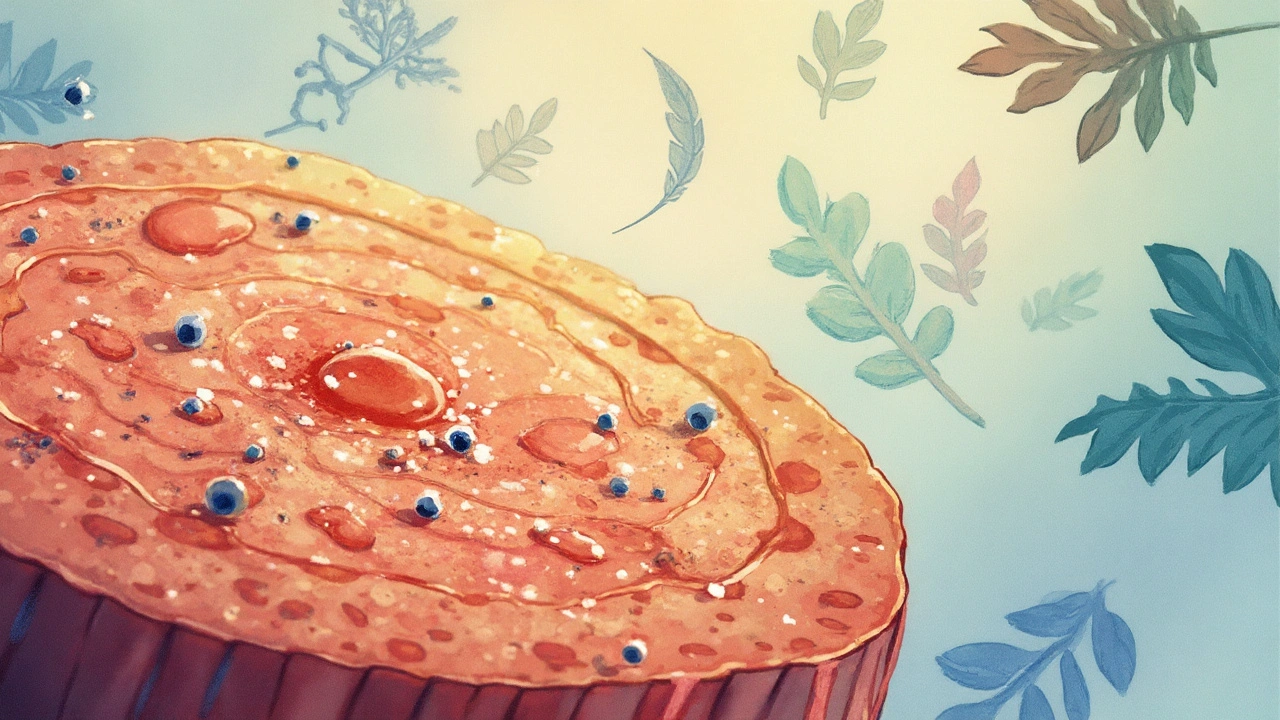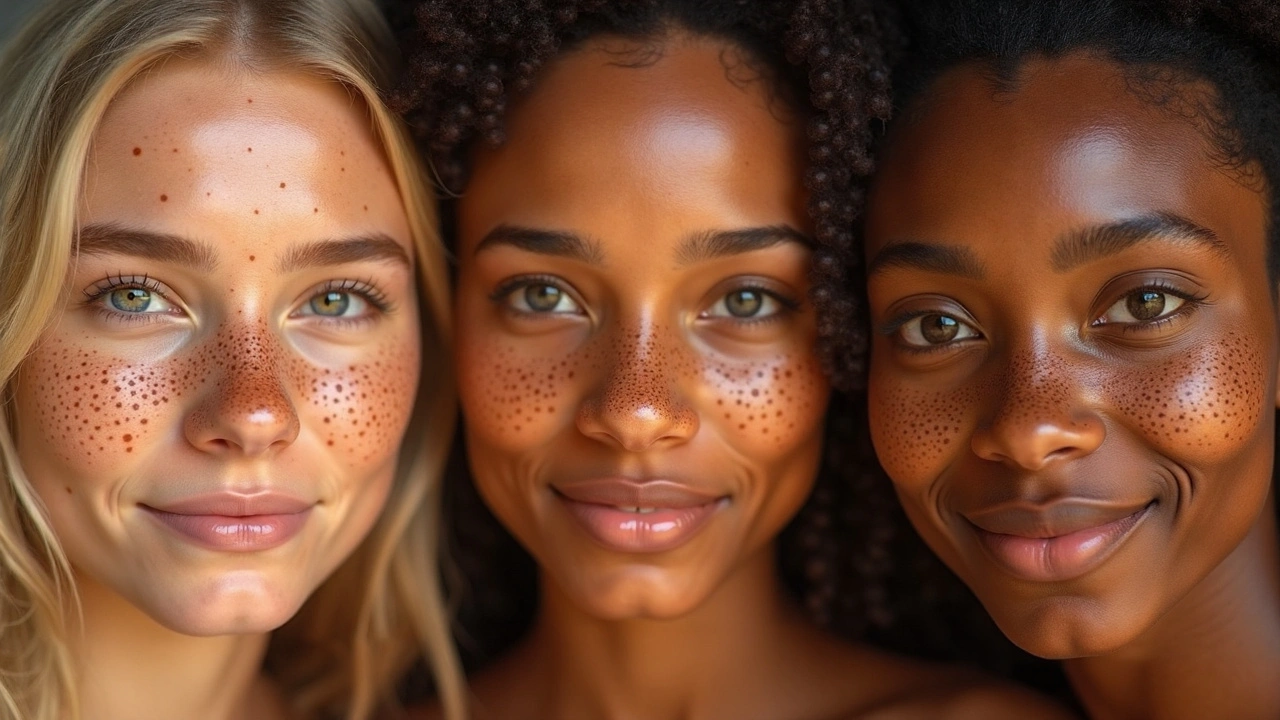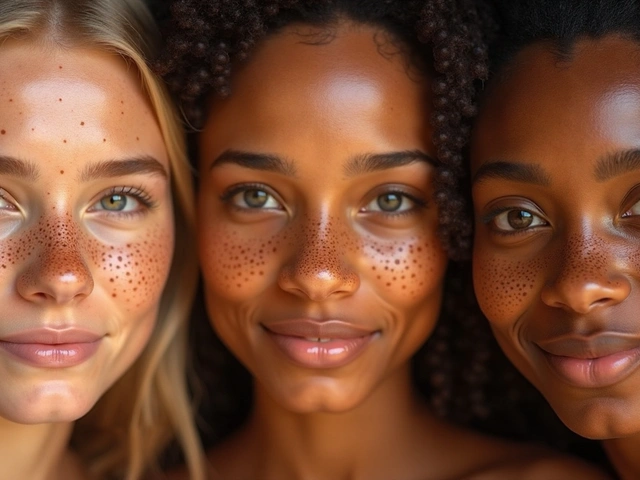Freckles are small, flat spots of increased pigment that appear on sun‑exposed skin. They form when melanin clusters in the upper epidermis, creating a pattern that can range from barely noticeable to strikingly dark. While many think of freckles as a whimsical beauty trait, they actually carry clues about your melanin production, genetic background, and how your skin reacts to UV radiation.
Understanding freckles goes beyond aesthetics; it’s a window into your ancestry and the genes that shape your skin’s response to the sun.
Major Freckle Varieties
Not all pigmented spots are created equal. Dermatologists group them into several distinct categories, each with its own cause and ancestry signal.
- Ephelides - the classic “sun freckles” most common in people with fair skin.
- Lentigines - darker, often larger spots that persist regardless of sun exposure.
- Cafe‑au‑lait spots - light brown patches present from birth, linked to certain genetic conditions.
- MC1R‑related freckles - freckles driven by specific variants of the melanocortin‑1‑receptor gene.
Ephelides: The Sun‑Triggered Freckle
Ephelides are the most recognizable form of freckles. They appear after repeated exposure to ultraviolet (UV) radiation, especially in individuals with a high proportion of pheomelanin, the reddish‑yellow pigment that gives hair a blond or red hue. The hallmark of ephelides is their tendency to fade in winter and darken in summer.
Genetically, ephelides are strongly associated with loss‑of‑function variants in the MC1R gene. Studies of Northern European cohorts (e.g., a 2023 UK Biobank analysis) show that people carrying two non‑functional MC1R alleles are up to 4 times more likely to develop ephelides.
Lentigines: Age‑Related and Sun‑Independent Spots
Lentigines, sometimes called “age spots” or “solar lentigines” when they arise later in life, differ from ephelides in two key ways. First, they consist of increased numbers of melanocytes rather than just more melanin. Second, they do not fade with reduced sun exposure. Their color ranges from light tan to dark brown, and they often appear on the face, hands, and shoulders.
While anyone can develop lentigines, they are more prevalent among people with moderate to high levels of eumelanin, the dark brown-black pigment typical of Mediterranean, Middle Eastern, and some Asian ancestries. The presence of lentigines can hint at a mixed ancestry where both pheomelanin and eumelanin pathways are active.
Cafe‑au‑lait Spots: Birth‑Mark Freckles
Cafe‑au‑lait spots are flat, uniformly pigmented patches that usually appear in childhood. They are not caused by UV exposure but by localized overproduction of melanin during skin development. While most individuals have one or two spots, having six or more raises the risk for neurofibromatosis type1 (NF1), a genetic disorder more common in people of European descent.
These spots serve as a reminder that not all pigmented lesions are linked to sun or ancestry; some are purely developmental.
MC1R‑Related Freckles: The Genetic Signature
The MC1R gene encodes a receptor that controls the switch between eumelanin and pheomelanin production. Certain alleles (e.g., R151C, R160W, D294H) reduce the receptor’s ability to stimulate eumelanin, resulting in a higher pheomelanin ratio and a propensity for freckling.
These alleles are most frequent in Celtic and Germanic populations. A 2022 genome‑wide study of 15,000 individuals from the Iberian Peninsula found a 22% carrier rate for the R151C variant, correlating with higher freckle density on the face and arms.

What Your Freckles Reveal About Ancestry
By looking at the type, distribution, and genetic background of your freckles, you can infer several ancestry‑related traits:
- European (Northern) ancestry: High prevalence of ephelides, MC1R loss‑of‑function variants, light eye color, and a tendency toward fair skin (Fitzpatrick phototypeI‑II).
- Mediterranean or Southern European ancestry: Mixed ephelides and lentigines, moderate eumelanin levels, and Fitzpatrick phototypeIII‑IV.
- African or Sub‑Saharan ancestry: Fewer ephelides, more uniform eumelanin, darker baseline skin (phototypeV‑VI), and occasional lentigines that are less contrastive.
- Indigenous American ancestry: Variable freckle patterns; some groups show higher rates of ephelides linked to specific MC1R haplotypes distinct from European ones.
These patterns are averages, not absolutes. Gene flow, migration, and personal sun habits all blur the lines, but the statistical trends are strong enough that forensic anthropologists use freckle data as one piece of a larger ancestry puzzle.
Comparison of Freckle Types
| Attribute | Ephelides | Lentigines | Cafe‑au‑lait | MC1R‑related |
|---|---|---|---|---|
| Typical Color | Light tan to reddish | Medium to dark brown | Uniform light brown | Reddish‑yellow |
| Onset Age | Childhood‑early teens | Adulthood (30+) | Present at birth | Childhood‑early teens |
| UV Sensitivity | High (darken with sun) | Low (persist regardless) | Low (developmental) | High (linked to MC1R) |
| Primary Genetic Link | MC1R loss‑of‑function | Increased melanocyte count | Localized melanin overproduction | Specific MC1R alleles (R151C, R160W) |
| Associated Ancestry | Northern European, Celtic | Mediterranean, mixed | Broad; notable in NF1 cases | Germanic, some Iberian |
Related Concepts and How They Interact
Freckles don’t exist in a vacuum. Several biological and environmental factors shape their appearance.
- Melanin - the pigment that determines skin, hair, and eye color. Two forms dominate: pheomelanin (lighter, red‑yellow) and eumelanin (darker, brown‑black).
- UV Radiation - the part of sunlight that triggers melanin production. UVA penetrates deeper, while UVB stimulates melanin synthesis directly.
- Skin Phototype (Fitzpatrick scale) - categorizes skin’s reaction to UV. TypesI‑II are most prone to ephelides; typesV‑VI show fewer.
- Genetic Ancestry - the genetic heritage that influences MC1R, OCA2, and other pigmentation genes.
Understanding these connections helps you interpret what your own freckle pattern says about both your biology and your lifestyle.
Practical Tips for Managing Freckles
Whether you love your freckles or want to even them out, here are evidence‑based steps:
- Daily Sun Protection: Apply a broad‑spectrum SPF30+ sunscreen every morning. Reapply every two hours outdoors.
- VitaminC Serum: Antioxidant serums can reduce melanin oxidation, lightening ephelides over weeks.
- Topical Hydroquinone or Kojic Acid: For lentigines, 2% hydroquinone applied nightly may fade spots in 8‑12 weeks.
- Laser or Intense Pulsed Light (IPL): Dermatologists use these to target melanocytes in lentigines. Best for stable, larger spots.
- Genetic Testing (optional): Companies offer MC1R testing. Knowing your variant can guide sun‑care intensity.
Remember: freckle management is about protecting skin health, not just cosmetic change.
Next Steps for Curious Readers
If you want to dig deeper, consider exploring these topics next:
- “Understanding the Fitzpatrick Skin Phototype Scale” - a broader look at how skin reacts to UV.
- “The Role of OCA2 and HERC2 Genes in Eye Color and Freckling” - genetics beyond MC1R.
- “Sun‑Induced DNA Damage and Skin Cancer Risk” - why protecting freckles matters.

Frequently Asked Questions
Why do freckles fade in winter?
Freckles, especially ephelides, form when UV radiation stimulates melanin production. In winter, UV exposure drops dramatically, so melanocytes produce less pigment and the existing melanin disperses, causing freckles to appear lighter.
Can I inherit freckles from my parents?
Yes. Freckles have a strong genetic component, primarily linked to variants of the MC1R gene. If both parents carry loss‑of‑function alleles, the chance of children developing noticeable freckles rises sharply.
Are freckles a sign of skin cancer risk?
Freckles themselves are harmless, but they indicate a skin type that is more sensitive to UV damage. People with many ephelides should be diligent about sunscreen, as their skin may accumulate DNA damage faster.
Do all ethnic groups develop freckles?
Freckles are most common in lighter‑skinned populations because they have more pheomelanin, which reacts visibly to UV. Darker‑skinned groups can develop lentigines, but classic ephelides are rarer.
How can I tell if a spot is a freckle or a mole?
Freckles are flat, uniform in color, and often change with sun exposure. Moles (nevi) are usually raised or have varied coloration and stay the same regardless of sun. If unsure, have a dermatologist evaluate it.

